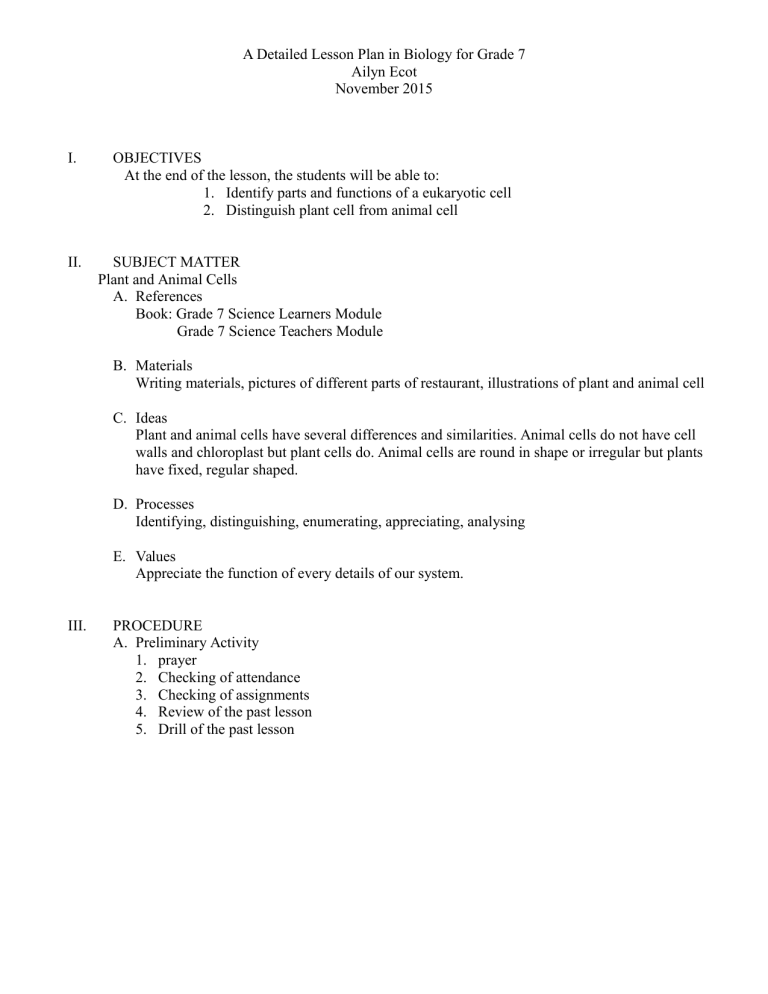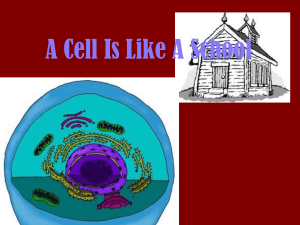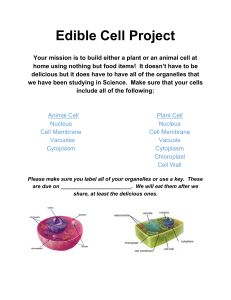
A Detailed Lesson Plan in Biology for Grade 7 Ailyn Ecot November 2015 I. II. OBJECTIVES At the end of the lesson, the students will be able to: 1. Identify parts and functions of a eukaryotic cell 2. Distinguish plant cell from animal cell SUBJECT MATTER Plant and Animal Cells A. References Book: Grade 7 Science Learners Module Grade 7 Science Teachers Module B. Materials Writing materials, pictures of different parts of restaurant, illustrations of plant and animal cell C. Ideas Plant and animal cells have several differences and similarities. Animal cells do not have cell walls and chloroplast but plant cells do. Animal cells are round in shape or irregular but plants have fixed, regular shaped. D. Processes Identifying, distinguishing, enumerating, appreciating, analysing E. Values Appreciate the function of every details of our system. III. PROCEDURE A. Preliminary Activity 1. prayer 2. Checking of attendance 3. Checking of assignments 4. Review of the past lesson 5. Drill of the past lesson Teacher Activity B. Motivation Good afternoon class! How are you this day? Okay, since you are fine, I guess you are ready for our class this afternoon. I have here some pictures and as I flashes it before you, I would like you to give me the function of it. Okay? (Shows a picture of a door) (Shows a picture of a wall) (Shows a picture of fridge) (Shows a picture of floor, tables and chairs) (Shows a picture of waiter and waitress) (Shows a picture of a take-out box) (Shows a picture of a chef) (Shows a picture of line-up cooks) (Shows a picture of a janitor) Okay, where can we find them? These pictures, the chefs, the waiters and waitresses, the refrigerator, the take-out box, the door, the wall, is what comprises the restaurant. This is their basic structural and functional unit. Same with the eukaryotes, we also have our basic structural and functional unit. Can someone tell me what is it? Student Activity We’re fine ma’am! Yes ma’am! It lets people in and out of the room! It protects what is inside the room ma’am! It stores food! It caters all the people around it ma’am! They serve as the organizer ma’am by serving food! Packages the food that the costumer wants to take out ma’am! That’s the chef, it cooks food! That’s still a chef but they are many, they convert the ingredients to a ready to eat food! That’s a janitor, it cleans the establishment ma’am! At a restaurant ma’am! The cell ma’am! That’s right! And today, we are going to tackle about the plant and animal cell. C. Lesson Proper. Before we start our lesson, we are going to have an activity. Are you ready class? Count of from 1 to 3. (Gives the materials for the activity) the title of our activity is comparing plant and animal cell. Okay, can someone read the objectives for your activity? Yes ma’am! Jecca, please read the directions. Compare plant and animal cell below. Draw a Venn diagram to show the similarities and differences of the two cells. Write your answers on the manila paper and post it in the board. Late answers will be deducted from their gained points (according to the (the students form their groups) Objectives: After doing this activity, you should be able to Identify parts of the cell; Describe plant and animal cell; Differentiate plant cells from animal cells; Construct a Venn diagram to show parts that are common to both and parts that are only found in either plant or animal cells. correct answers given). Choose a representative to report your groups’ work. Are the directions clear? Is there any questions? No ma’am! This activity is good for 5 minutes, it is important that each member will cooperate. Okay? You may start now. (After 5 minutes) (students answer their activity) Okay, let’s check if your answers were correct. Just like a restaurant, a cell also has many components or parts in order for them to work efficiently. Now, let’s take a look at this illustration. (shows a picture of animal cell) What have you observed in the illustration? How about this? (shows a picture of plant cell) They are composed of many parts ma’am and is circular in shape. (students report their works) They have the same components ma’am but that cell is rectangular in shape. Both cells have almost the same parts. Now let’s take a look at these two cells. There are three components of a cell, the cytoplasm, the nucleus and the cell membrane. Let’s look at first the nucleus. It is found in the center of the cell. Can someone point out where is the nucleus? What is the function of the nucleus? (student points out the nucleus) Almost all of the activities of the cell is directed by the nucleus. Now let’s go to the cell membrane, it is the outer layer of the animal cell, it encloses other organelles. Can someone points out where the cell membrane is? It is also called semipermeable membrane. Why is it called semipermeable? (student points out the cell membrane) What would happen if the cell membrane does not function properly? Without plasma membrane, any substances can go in and out of the cell. The cell may be affected by the exit of the needed substances or the entrance of unneeded substances or the poisonous substances that can lead to death of the cell. (student points out the cell wall) It is the control center of the cell ma’am! It allows specific molecules to pass through and blocking others. Okay, now, let’s go to the cell wall. It is found just outside of the cell membrane. Can someone point out where is the cell wall? Can we found this in both cells? No ma’am, we can only find this on the plant cell. What is the purpose of cell wall in plants? Okay, now let’s go to the cytoplasm. It is where the other organelles are suspended. Can someone point out where is the cytoplasm? What is the function of the cytoplasm? It gives them shape and protection to plant cell because they are tough or rigid. (student points out the cytoplasm) It maintains the osmotic concentration of the cells and prevents them from shrinking or bursting. Now mitochondria is one of the organelles that is found in the cytoplasm, it is an oval shape organelle and is surrounded by a double membrane. Where is mitochondria in the cell? What is the function of mitochondria? (student points out the mitochondria) It is the powerhouse of the cell. Yes, it produces energy that is needed by the body. How about the endoplasmic reticulum? What is the function of the endoplasmic reticulum? It is a large network of tubes and is like maze or folds. It carries proteins to different parts of the cell. There are two types of endoplasmic reticulum, what are they? What makes it rough? The smooth and the rough endoplasmic reticulum. What is a ribosome then? Ribosomes are circular in shape and are either free or attached to the endoplasmic reticulum. (student points out the ribosomes) Can someone point out where is the ribosome is? Okay. This one’s here is the lysosome they break down the waste products and detoxify the cell. The Golgi apparatus are like flattened stacks of sacs, where is the Golgi apparatus in the illustration? What is the function of Golgi apparatus? The vacuoles on the other hand are organelles for storage. It is easily seen in plant cell because they have large vacuoles. Can someone point out the vacuoles? How would vacuoles in plants serve as defense against animals that eat them?? Chloroplasts is an elongated or disc-shaped organelle, can someone point out the chloroplast? Where can we find them? What is the function of chloroplast? Okay, chloroplast contains chlorophyll, a green pigment in plant which absorbs light energy from the sun and is the site of photosynthesis in plants. Why are there several chloroplast in the cell? The ribosomes make it rough. (student points out the Golgi apparatus) They function as the packaging unit of the cell, they sort and modify proteins. (student point out the vacuoles) Vacuoles in some plants may contain poison or toxic substances and these substances may harm animals once eaten, this serves as their protection. (student points out the chloroplast) Chloroplasts can be found only in plant cell. They are the site of photosynthesis in plants. It is the site of photosynthesis and the more the chloroplast in them makes them more efficient for making food. This one’s here is the centrosome, it organizes the cell parts during cell division. Okay let’s go back to the pictures. Let us connect Yes ma’am! their functions to the functions of the organelles. Are you ready? In a restaurant, you see its walls. What do these walls It refers to the cell wall ma’am! represents in the cell? Yes! That is because both the cell wall and the wall of the restaurant give the object structure and creates a barrier from what’s inside to what’s outside. How about the door of the restaurant? What does it do? That’s right! And it resembles to what? On the other hand, the chef is similar to the nucleus, why do you think so? That’s right! The nucleus is the control center of the cell just like the chef who’s the one in control in the restaurant on what food to make. The nucleolus is the same as the chef’s brain, would you agree? What do you think relates to the cytoplasm in the restaurant? Okay, the cytoplasm relates to the seating area and the area in the kitchen. A seating area contains all of the tables, and the kitchen contains all of the food, cooking tools, and the fridge. Since we’re talking about fridge, what does the fridge do? And it is the same as to what in the restaurant? How about the janitors? What do they represents? Line of cooks convert ingredients into meals convenient for the costumers to eat. What does it represent to a cell? Endoplasmic reticulum serves as the pathway of the restaurant, where the proteins, lipids and other components are assembled. How about the take out boxes? What do they represents? What is the cytoskeleton for? In a restaurant, the waiters and waitresses give the job structure and internal organization. The waiters and waitresses must be organized. Again, the difference between the animal and plant cell is that the shape of the plant cell is fixed and rectangular while in animal it is round and irregular. Also, plants have chloroplast, cell and large vacuoles while animals don’t.. Are there any clarification? Questions? The door lets the people enters in and out of the place. The cell membrane, because it determines what goes in and out of the cell, the only way for any molecule to get inside of the cell is through the membrane. Just like the door is the only way of the restaurant. The chef is like the nucleus because he/she is the one in control on what food to make and how to make it. Yes ma’am, because the chef’s brain contains valuable recipes needed for creating food. The chairs and tables’ ma’am and also the floor. They serve as storage for food or ingredient. The vacuole ma’am! Fridge stores food that the costumers will eventually eat and it is the same as the vacuole that stores food that the cell takes in. The janitor in the restaurant represents the lysosome because they are the one who digests old cell parts. The mitochondria. The take out boxes represents the Golgi apparatus because the Golgi apparatus modifies, sorts and packages proteins and other materials for storage, just like the take out boxes which is use for storing food. The cytoskeleton gives the cell shape and internal organization No ma’am. D. Generalization What are the difference between plant and animal cell? E. Application Draw a Venn diagram of the similarities and differences of the plant and animal cell. IV. EVALUATION Choose the letter of the correct answer. b. Which of the following structures let substances pass in and out of the plant and animal cell? a. Cell membrane b. Cell wall c. Epidermis d. Mitochondria 2. Which part of the cell contains a green pigment needed for photosynthesis? a. Centrosome b. Chromosome c. Cytoplasm d. Chloroplast 3. This is the powerhouse of the cell. a. Lysosome b. Ribosome c. Mitochondria d. Nucleolus 4. Which organelle is found only in a plant cell? a. Chloroplast b. Cell wall c. Both a & b d. None of the above 5. What part of the cell contains instructions and information to be sent to all parts of the cell? a. Mitochondria b. Nucleolus c. Nucleus d. Ribosome V. ASSIGNMENT Draw a typical cell and label its parts. Submit these in a short bond paper next meeting. A DETAILED LESSON PLAN IN SCIENCE FOR GRADE 7 Ailyn S. Ecot October 2015 I. OBJECTIVES At the end of a 60-minute period, the Grade 7 students will be able to: 1. Identify the parts and functions of a eukaryotic cell; and 2. Distinguish plant cell from animalcell II. SUBJECT MATTER PLANT AND ANIMAL CELL A. REFERENCES Book: grade 7 learners module Internet: B. Materials Writing materials, pictures and illustrations of different restaurant facility, adhesive tape, markers, bondpaper C. Ideas Plant and animal cell have several differences and similarities. Animals cells do not have a cell wall and chloroplasts but plant cells do. Animal cells are round and irregular in shape while plants have fixed, rectangular shape. D. Processes Identifying, distinguishing, enumerating, appreciating, analyzing E. Values integration Thankfulness that our body is composed of tiny structures yet functioning a big role. III. PROCEDURE A. Preliminary Activity 1. Prayer 2. Checking of attendance 3. Checking of assignments 4. Review of the past lesson 5. Drill of the past lesson








